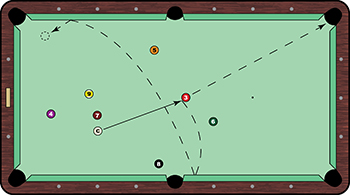This eye-pleasing punch draw shot can be a great weapon.
Something a little different this month. Not really a drill, but well worth setting up and practicing.
Iím talking about the punch draw shot to get out of rough situations. The punch draw will allow you to get unnatural draw for shape. Itís a shot I see amateurs and even pros struggle with. It is a shot that requires constant practice because it is not quite your normal stroke. You need to be more creative and braver, and you need to trust your ability to execute this shot. That is why it requires a fair amount of practice.
As the diagram shows, Iíve got a slight angle on the 3 ball but not a natural angle. If I play a normal draw shot from this spot (flat cue, normal stroke), I will probably scratch in the side pocket. Because itís not easy to get action on the cue ball, most amateurs panic and hit the shot too hard. More times than not, they either miss the shot altogether, miscue or scratch.

Hereís how to execute this shot: You need to bridge a little higher than normal for this shot, aiming slightly down at the cue ball. The contact point on the cue ball should be just below center with perhaps a touch of right English. This is a punch stroke, which should not be confused with a quick, jerky stroke. To avoid a jerky stroke, your backstroke should be a little longer than normal. Keep a loose grip on the butt of the cue and drive through the cue ball more than usual. You want the cue going right through the cue ball a good 5-10 inches. This will generate the power to get the cue ball to draw two rails, especially off the second rail. Itís a crowd-pleasing, impressive looking shot, but itís also an important one to have in your toolbox. This type of layout comes up more often than you might think, and this is the only shot that will get you shape on the 4 ball.
Again, this is a shot that requires a lot of practice. But when you get proficient at it, this shot will increase your confidence and allow you to escape some tricky situations. Just knowing you have the ability and the cue power to get out of this tough predicament is a big boost.
This is also a great shot to help you get in stroke. If you feel a bit rusty and want to let your stroke out, this shot will do it. You will also gain a better understanding of cue ball physics and how the rails react.
Remember, a little more elevation on the cue and a little extra back stroke will help get the job done. Be sure to hit slightly below center and, in this particular case, a little right English. (On old, worn cloth you may have to dig even deeper into the cue ball.)
Some people may look at this as an exhibition shot, but it isnít. This is a very important shot to have in your pool toolbox. Having a little fun at the same time is a bonus.





